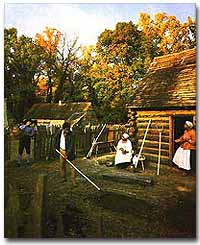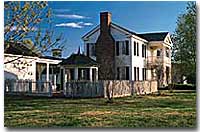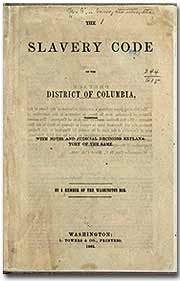27b. Slave Life and Slave Codes

Slave life varied greatly depending on many factors.
Life on the fields meant working sunup to sundown six days a week and having food sometimes not suitable for an animal to eat. Plantation slaves lived in small shacks with a dirt floor and little or no furniture. Life on large plantations with a cruel overseer was oftentimes the worst. However, work for a small farm owner who was not doing well could mean not being fed.
The stories about cruel overseers were certainly true in some cases. The overseer was paid to get the most work out of the slaves; therefore, overseers often resorted to whatever means was necessary. Sometimes the slaves would drive the overseer off the plantation in desperation. When slaves complained that they were being unfairly treated, slaveholders would most often be very protective of their "property" and would release the overseer.

Slaves who worked inside the plantation homes often had better living and working conditions than slaves who worked in the fields.
In some cases, a driver was used rather than an overseer. The difference between the overseer and the driver was simple: drivers were slaves themselves. A driver might be convinced by a master to manage the slaves for better privileges. Drivers were usually hated by the rest of the slaves. These feelings often led to violence.
Large plantations often required some slaves to work in the plantation home. These slaves enjoyed far better circumstances. Domestic slaves lived in better quarters and received better food. They sometimes were able to travel with the owner's family. In many cases, a class system developed within the slave community. Domestic slaves did not often associate themselves with plantation slaves. They often aspired to arrange courtships for their children with other domestic slaves.

This Slave Code booklet for Washington D.C., was published in 1862, only one month before Lincoln abolished slavery in the nation's capitol. More lenient than most states' slave codes, the District's code allowed slaves to hire themselves out and live apart from their masters.
As the Peculiar Institution spread across the South, many states passed "slave codes," which outlined the rights of slaves and the acceptable treatment and rules regarding slaves. Slave codes varied from state to state, but there were many common threads. One could not do business with a slave without the prior consent of the owner. Slaves could be awarded as prizes in raffles, wagered in gambling, offered as security for loans, and transferred as gifts from one person to another.
A slave was not permitted to keep a gun. If caught carrying a gun, the slave received 39 lashes and forfeited the gun. Blacks were held incompetent as witnesses in legal cases involving whites. The education of slaves was prohibited. Anyone operating a school or teaching reading and writing to any African-American in Missouri could be punished by a fine of not less than $500 and up to six months in jail. Slaves could not assemble without a white person present. Marriages between slaves were not considered legally binding. Therefore, owners were free to split up families through sale.
Any slave found guilty of arson, rape of a white woman, or conspiracy to rebel was put to death. However, since the slave woman was chattel, a white man who raped her was guilty only of a trespass on the master's property. Rape was common on the plantation, and very few cases were ever reported.






